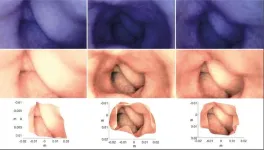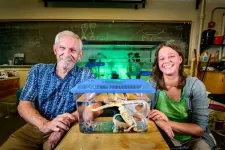(Press-News.org) How can artificial intelligence and machine learning be used for innovative research in the field of soft matter? Frauke Gräter, the current Head of the Molecular Biomechanics group at the Heidelberg Institute for Theoretical Studies (HITS) and Professor of Molecular Biomechanics at Heidelberg University, will research these and other topics as the new Director at the MPI for Polymer Research starting July 1, 2024.
Frauke Gräter has made an international name for herself through her outstanding scientific contributions, particularly in the field of molecular biomechanics. Her academic career is distinguished by positions at prestigious institutions all over the world. After studying chemistry at the Universities of Tübingen, Kyoto, and Heidelberg, she completed her doctorate at the Max Planck Institute for Biophysical Chemistry in Göttingen. She spent her postdoctoral period at the Department of Chemistry at Columbia University in New York and at the Max Planck Institute in Göttingen. In Shanghai, she led her first group "Protein Mechanics and Evolution" at the MPG-CAS Partner Institute for Computational Biology (PICB), after which she continued her scientific career at HITS in Heidelberg as a group leader and later as a professor at the University of Heidelberg.
Frauke Gräter's primary research interest is the fundamental question of how mechanical forces influence biochemical processes in living organisms. With her interdisciplinary approach, which includes experimental methods, high-performance computing, and molecular simulation techniques, she has made new discoveries in areas ranging from blood coagulation to materials research on spider silk and collagen. Her work has received numerous awards, including the "PRACE Ada Lovelace Award for HPC" and an ERC Consolidator Grant from the European Research Council, further confirming her status as a leading scientist in her field.
As the new director, Frauke Gräter will not only contribute her scientific expertise, but also her vision for the future of the Institute. Her previous experience in leading research groups and her active participation in scientific collaborations form the basis for innovative cooperation.
"I'm looking forward to working and researching at the MPI for Polymer Research in the future and to driving forward my own research projects as well as developing joint research projects with the other departments at the Institute," says Gräter.
The concepts and methods developed by Frauke Gräter ideally complement the ongoing experimental work in the Institute's other five departments. In particular, the study of the structure formation of materials under non-equilibrium conditions is hugely relevant at the MPI-P. In the future, this should make it possible to produce materials with complex, life-like properties that can communicate with biological systems by receiving and processing signals. There are also plans to use artificial intelligence to predict chemical processes and electron transfer in material systems.
"We are delighted to have gained a top-class scientist for our Institute in Frauke Gräter," states Prof. Mischa Bonn, Managing Director of the Institute. "Her expertise offers our Institute tremendous added value for the understanding and development of new material systems."
The appointment of Frauke Gräter is a real boon for the Max Planck Society and promises a continuation of the tradition of excellent research, as well as new impulses and perspectives.
END
Frauke Gräter appointed new director at the Max Planck Institute for Polymer Research
Pioneering research into soft matter
2024-06-25
ELSE PRESS RELEASES FROM THIS DATE:
Scientists demonstrate for first the time that a group of butterflies flies across the Atlantic Ocean
2024-06-25
An international team of researchers, led by the Spanish National Research Council (CSIC), has documented a transoceanic flight of more than 4200 km by painted lady butterflies (Vanessa cardui), setting a record for an insect.
The study, published in the journal Nature Communications, involved researchers from the Botanical Institute of Barcelona (IBB), a joint center of the CSIC and the Natural Sciences Museum of Barcelona, as well as from the W. Szafer Botanical Institute (Poland), the University of Ottawa (Canada), the Institute of Evolutionary ...
Oncolytic virus senecavirus A inhibits hepatocellular carcinoma proliferation and growth by inducing cell cycle arrest and apoptosis
2024-06-25
Background and Aims
Hepatocellular carcinoma (HCC) is a highly aggressive tumor with limited treatment options and high mortality. Senecavirus A (SVA) has shown potential in selectively targeting tumors while sparing healthy tissues. This study aimed to investigate the effects of SVA on HCC cells in vitro and in vivo and to elucidate its mechanisms of action.
Methods
The cell counting kit-8 assay and colony formation assay were conducted to examine cell proliferation. Flow cytometry and nuclear staining were employed to analyze cell cycle distribution and apoptosis occurrence. ...
Brain connectivity on MRI predicts Parkinson’s disease progression
2024-06-25
OAK BROOK, Ill. – The structural and functional organization of the brain as shown on MRI can predict the progression of brain atrophy in patients with early-stage, mild Parkinson’s disease, according to a study published today in Radiology, a journal of the Radiological Society of North America (RSNA).
Parkinson’s disease is a progressive disorder characterized by tremors, slowness of movement or rigidity. Symptoms worsen over time and may include cognitive impairment and sleep problems. The disease affects more than 8.5 million people worldwide, and prevalence has doubled in the past 25 years, according to the World Health Organization (WHO).
One of ...
Carnegie Mellon University School of Computer Science launches CMU TechBridge Coding Bootcamp
2024-06-25
The School of Computer Science at Carnegie Mellon University has launched the CMU TechBridge Coding Bootcamp to provide access to computer science education and career opportunities for high school (or equivalent) graduates.
The bootcamp will extend the reach of CMU’s computer science education offerings beyond its traditional undergraduate and graduate programs. CMU has partnered with TalentSprint to implement the program to help aspiring professionals build the skills required for launching and ...
Weill Cornell Medicine awarded Department of Defense grant for prostate cancer bone metastases research
2024-06-25
Weill Cornell Medicine received a $1.5 million grant from the U.S. Department of Defense Prostate Cancer Research Program to develop new approaches for predicting the spread of cancer cells to the bone in men with prostate cancer, using tumor samples taken at early stages of the disease.
The American Cancer Society projects about 35,250 deaths from prostate cancer in the United States in 2024. “Metastases, especially to the bone, is the leading cause of death in men who have prostate cancer,” said principal investigator Dr. Mohamed Omar, assistant professor of research in pathology and laboratory medicine, division ...
New 3D models of the colon can help detect disease more rapidly
2024-06-25
“Our work shows that it is possible to re-create a fairly accurate three-dimensional (3D) model of the colon of some patients based on a single image taken by a capsule endoscopy camera - even if it's a low-quality image,” says Pål Anders Floor, a researcher at the Department of Computer Science at NTNU.
Goal: better images, faster diagnoses
He has been working for several years on using images from capsule endoscopy cameras to reconstruct an almost identical 3D model of the intestines. These cameras were first used more than 20 years ago, but low-quality images and image noise prevented this smart technology from ...
Study challenges ED protocols for geriatric head injuries and blood thinners
2024-06-25
Falls are the most common cause of injury among adults 65 and older in the United States. According to the U.S. Centers for Disease Control and Prevention, every year, more than 14 million older adults (one in four) report a fall. About 90% of head injuries among older individuals is due to ground-level falls.
Evaluating an older adult with a head injury in the emergency department (ED) requires careful assessment due to the increased risk of complications such as intracranial hemorrhage. There also is heightened concern for older patients taking anticoagulants or blood thinners who sustain ...
Team aims to improve safety of fertilizers made from wastewater sludge
2024-06-25
Fertilizers manufactured from the sludgy leftovers of wastewater treatment processes can contain traces of potentially hazardous organic chemicals, according to a new study by Johns Hopkins University researchers.
The research, published today in Environmental Science & Technology journal, provides one of the most comprehensive looks at the chemical composition of so-called biosolids across the country and is the first step toward identifying common chemical contaminants that may need government regulation. The findings could ...
From 'CyberSlug' to 'CyberOctopus': New AI explores, remembers, seeks novelty, overcomes obstacles
2024-06-25
CHAMPAIGN, Ill. — By giving artificial intelligence simple associative learning rules based on the brain circuits that allow a sea slug to forage — and augmenting it with better episodic memory, like that of an octopus — scientists have built an AI that can navigate new environments, seek rewards, map landmarks and overcome obstacles.
Reported in the journal Neurocomputing, the new approach gives AI the ability to explore and gather the information it needs to expand its spatial and temporal awareness, growing its knowledge base while learning on the job, said Ekaterina Gribkova, a postdoctoral researcher at the University of Illinois Urbana-Champaign who ...
The evolution of firefly lights
2024-06-25
The leading hypothesis for the origin of firefly lights has been overturned by a genomic analysis. It had been posited that the bright lights emitted by many species in the Lampyridae family of beetles—better known as fireflies—first evolved as a warning signal to predators, advertising the toxicity of fireflies, and were then repurposed as a mating signal. This explanation would account for why eggs, larvae, and pupae also glow. Ying Zhen and colleagues put the conventional wisdom to the test by compiling a family tree of fireflies and tracing the evolution of the chemical compounds ...
LAST 30 PRESS RELEASES:
What causes some people’s gut microbes to produce high alcohol levels?
Global study reveals widespread burning of plastic for heating and cooking
MIT study shows pills that communicate from the stomach could improve medication adherence
Searching for the centromere: diversity in pathways key for cell division
Behind nature’s blueprints
Researchers search for why some people’s gut microbes produce high alcohol levels
Researchers find promising new way to boost the immune response to cancer
Coffee as a staining agent substitute in electron microscopy
Revealing the diversity of olfactory receptors in hagfish and its implications for early vertebrate evolution
Development of an ultrasonic sensor capable of cuffless, non-invasive blood pressure measurement
Longer treatment with medications for opioid use disorder is associated with greater probability of survival
Strategy over morality can help conservation campaigns reduce ivory demand, research shows
Rising temperatures reshape microbial carbon cycling during animal carcass decomposition in water
Achieving ultra-low-power explosive jumps via locust bio-hybrid muscle actuators
Plant-derived phenolic acids revive the power of tetracycline against drug-resistant bacteria
Cooperation: A costly affair in bacterial social behaviour?
Viruses in wastewater: Silent drivers of pollution removal and antibiotic resistance
Sub-iethal water disinfection may accelerate the spread of antibiotic resistance
Three in four new Australian moms struggle with body image
Post-stroke injection protects the brain in preclinical study
Cardiovascular risk score predicts multiple eye diseases
Health: estimated one in ten British adults used or interested in GLP-1 medications for weight loss
Exercise to treat depression yields similar results to therapy
Whooping cough vaccination for pregnant women strengthens babies’ immune system
Dramatic decline in new cases of orphanhood in Uganda driven by HIV treatment and prevention programs
Stopping weight loss drugs linked to weight regain and reversal of heart health markers
Higher intake of food preservatives linked to increased cancer risk
Mass General Brigham–developed cholera vaccine completes phase 1 trial
First experimental validation of a “150-year-old chemical common sense” direct visualization of the molecular structural changes in the ultrafast anthracene [4+4] photocycloaddition reaction
Lack of support for people on weight loss drugs leaves them vulnerable to nutritional deficiencies, say experts
[Press-News.org] Frauke Gräter appointed new director at the Max Planck Institute for Polymer ResearchPioneering research into soft matter







